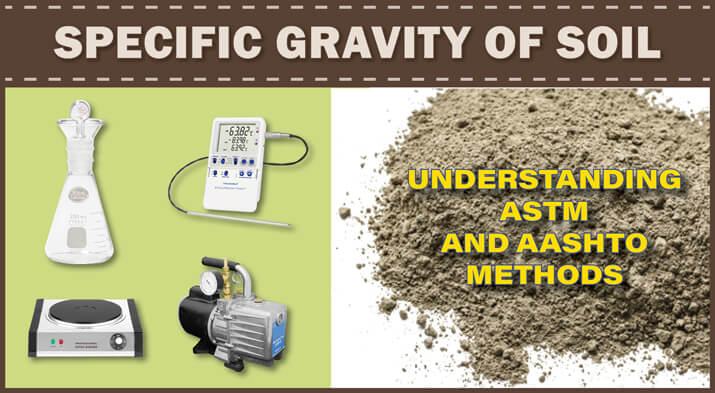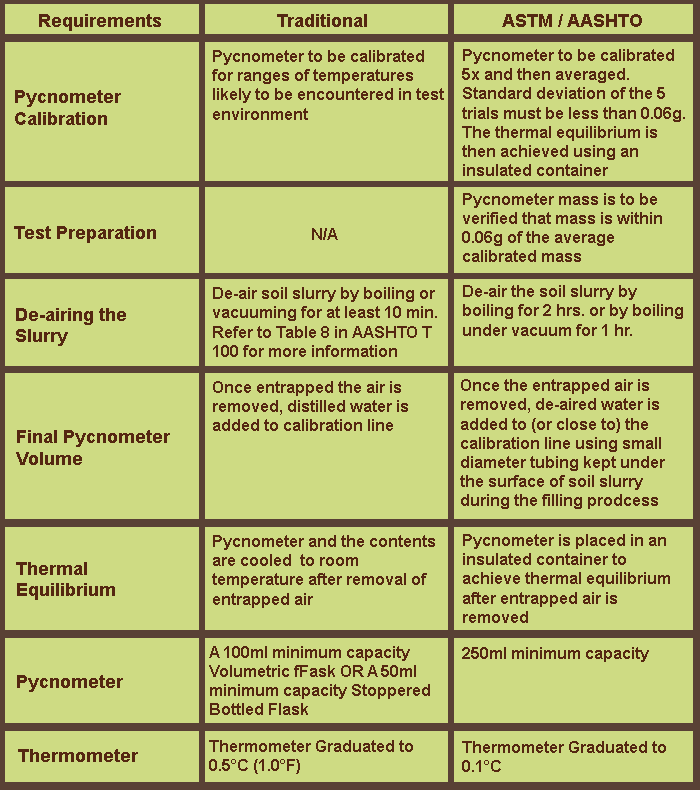
The Importance of Soil Specific Gravity
Specific gravity is a fundamental property of soils and other construction materials. This dimensionless unit is the ratio of material density to the density of water and is used to calculate soil density, void ratio, saturation, and other soil properties. Applications include the foundation design for structures, calculations for the stability of soil embankments, and estimations of settlement for engineered soil fills.
Determining Specific Gravity of Soil
Traditional methods for determining specific gravity are straightforward. Standard test methods described by some state DOTs, and in the U.S. Army Corps of Engineers laboratory soils testing manual, are often considered adequate for basic applications. As with any laboratory test, these methods require attention to detail but are easy to perform correctly and do not require much in the way of specialized techniques or equipment.
ASTM D854, and the identical AASHTO T 100, Standard Test Methods for Specific Gravity of Soil Solids by Water Pycnometer, focus on producing measurements with a high degree of precision. While the equipment required is not sophisticated, the procedures are extensive and meticulous, and performing the test by the book can be a challenge. Practitioners should be aware of the significant differences between the test methods. Reliable test results depend on strict adherence to the practices and techniques outlined. This blog post will focus on the equipment and procedures used to perform the ASTM/AASHTO method.

Table Resource: aashtoresource.org
Specific Gravity Lab Equipment and Apparatus

- Pycnometers: the test method permits the use of a volumetric flask or iodine flasks with a stopper. Volumetric flasks are typically used but require careful adjustment of water to the calibration mark. For stoppered flasks, the stopper physically controls the water volume. A minimum capacity of 250ml is specified, and a 500ml capacity flask is sometimes required. Group image of 250ml, 500ml, and (unnamed) stoppered flasks.
- Thermometric Device: the thermometer must have readability to 0.1°C with an accuracy of ±0.5°C and be standardized to a NIST traceable device. Full-immersion thermometers are not permitted.
- Entrapped Air Removal: deairing of the water and soil slurry may be accomplished by boiling, application of a partial vacuum, or both. Using a heating plate or other apparatus can be used to heat the pycnometer. A vacuum pump or water aspirator that produces a vacuum of at least 100mm of mercury (approximately 26in) absolute pressure is needed for deairing. A digital residual pressure manometer is optional to monitor vacuum levels.
- Desiccator: a desiccator equipped with a desiccator plate and desiccant is required to cool the sample to room temperature after drying in an oven.
- Insulated Container: the pycnometers must be stored in an insulated container for temperature equilibration during calibration and testing. A plastic or Styrofoam container with room for three to six pycnometers plus a container of deaired water is usually sufficient.
- Pycnometer Filling Tube: when adding deaired water to the pycnometer during calibration or testing, it is essential to avoid turbulence or the introduction of air into the fluid. A purpose-built pycnometer filling apparatus can be fashioned following the description in the test method, or a length of 1/4in I.D. clear tubing added to a wash bottle will have the same effect.
- Blender: mixing the soil with water in a blender or “other suitable device” disperse the sample into a slurry. We suggest the soil dispersion mixer, typically used to prepare soil specimens for hydrometer analysis. A dispersion cup with no baffles is available for use with the mixer, contact our customer service department to order.
- Balance: a laboratory balance meeting ASTM D4753 requirements, with a capacity of at least 1,000g and readability to 0.01g, is sufficient for this test.
- Drying Oven: moisture determinations and final drying of the test solution are performed in a standard laboratory oven capable of maintaining a uniform temperature of 110 ±5°C.
- Test Sieve: this test method requires samples with particle sizes passing the ASTM E11 No.4 (4.75mm) mesh sieve.
Soil Specific Gravity Test Procedure
Calibrating the Pycnometer
Calibration of the pycnometers is the first phase for the ASTM/AASHTO method. The process is time-consuming but can be performed for up to six pycnometers at a time. The calibration procedure only needs to be performed once unless the mass of the pycnometer deviates from the calibrated value by 0.06g or more.
Each step for calibration is described in the test method, but here are the main points:
- Each clean and dry pycnometer is weighed five consecutive times. The standard deviation of the averaged weights must not exceed 0.02g.
- The pycnometers are filled with deaired water, placed in an insulated container, and allowed to come to thermal equilibrium for at least three hours. Locate the container near the balance to minimize handling.
- One pycnometer at a time is removed from the container, handling only by the rim, and the water level adjusted to the calibration mark.
- If additional water is needed, it must be deaired and thermally equilibrated, along with the water in the pycnometer.
- Excess water can be removed using a small suction tube or a paper towel.
- Measure and record the mass of each pycnometer to the nearest 0.01g.
- Measure and record the temperature in each pycnometer to the nearest 0.1°C.
- Repeat the above procedure five times for each pycnometer, with a three-hour thermal equilibration period between each step.
- Calculate and record the calibrated volume for each pycnometer.
It goes without saying that you will want to follow the steps outlined in the test method carefully to avoid having to repeat them!
Preparing the Sample
This specific gravity test method applies to soils passing the No. 4 (4.75mm) sieve. For soils that include larger particles, ASTM C127 determines the specific gravity of the fraction retained on the No. 4 test sieve. The test may be performed on either moist or oven-dried specimens, depending on the method requested.
Method A, the moist procedure, is preferred, and for some highly plastic, fine-grained, or organic soils, is required. The exact size of the test specimen is not predetermined. The table in the test method determines the range of the recommended mass for the sample, based on the soil classification from ASTM D2487.
- Verify that the empty pycnometer is within 0.06g of the calibrated mass. For method A, the soil must be dispersed by adding water and mixing it into a slurry using a blender or similar device.
- The slurry is transferred to the pycnometer. In method B for oven-dried soils, the dry sample is placed directly into the pycnometer, water added, the pycnometer is agitated into a slurry.
- The slurry is deaired by either boiling, application of vacuum, or a combination of the two. This process may take one to two hours and requires frequent or constant agitation depending on the method. A mechanical agitator provides the necessary level of mixing, removing the need for continuous attention.
- Deaired water is then added to bring the level near to the final calibrated volume.
- The pycnometer with the prepared sample is placed in the insulated container overnight and allowed to achieve thermal equilibrium.
Measuring the Mass and Temperature
The final step in performing the specific gravity tests is to determine the mass and the temperature of the suspension.
- The pycnometer is removed from the container, handling only the rim to avoid changes to thermal equilibrium, and placed on an insulated block.
- Final adjustments are made to the calibrated water level, and the pycnometer weighed on the laboratory balance.
- The temperature to the nearest 0.1°C is recorded using the same device used for calibration of the pycnometer.
Calculating Specific Gravity of Soil
The entire suspension is rinsed into a tared pan and oven-dried to determine the dry mass of the soil solids. The dried soil sample can cool in a desiccator and then weighed to the nearest 0.01g.
- The final specific gravity is calculated following the specific gravity of soil formulas in the test method, along with the density of water and temperature coefficient tables.
- The equations include corrections to factor in the specific gravity values for the fraction larger than the No.4 sieve size.
We hope this guide to the ASTM D854/AASHTO T 100 method and equipment has helped you understand the difference between this and some other test methods being used. Visit our Soil Specific Gravity Testing Equipment page to view all offerings.
Gilson Is Here to Help
Contact our testing experts for more information or to discuss your testing application.
Testing Resources
Standard Test Methods, Specifications, and Practices
Individual test methods and specifications referenced in our product descriptions, blog articles, and videos are available for review or purchase from the professional organizations noted.
- ASTM International (American Society for Testing and Materials)
- AASHTO (American Association of State Highway and Transportation Officials)
- ACI (American Concrete Institute)
- State DOTs (Departments of Transportation)
- ISO (International Organization for Standardization)
- BS (British Standards)
- EN (European Standards)

















